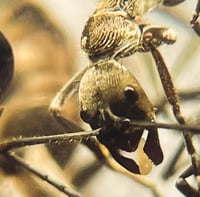Diacamma Violaceum
The larger counterpart of Diacamma rugosum, (and rarer) is Diacamma Violaceum, their agression pared with their slightly gold tinted gaster makes them an amazing species to watch, not to mention their relatively unique hierarchy system, allowing them to be a brilliant "display" species.
As you may know, ants in the genus "Diacamma" do not have queens, they instead function solely on "Gamergates" which are fertile workers. Workers will eclose from their cocoons, and if there is a gamergate present, they will be mutilated, and have their "Gemmae" (a gland which instructs the worker to lay eggs) removed, and if there isn't a gamergate present, the newly eclosed worker will not be mutilated, and instead fight other workers with their gemmae intact, in hopes to assert dominance, after this, normal workers will drag males from other colonies into the nest, and the gamergate will mate with them, allowing the colony to continue growing.
Our store colony of these beauties currently take up 2 Wakooshi Gen 4 nests, however we don't believe that Artificial works best for these ants due to their large size and sensitivity to light, so we will be moving them into a natural setup (ideally) soon.
The gamergate lays in cycles, similar to that of myrmecia, laying about 10 eggs a week for 2 weeks, then taking a 2-3 month break, until the last generation eclosed from their cocoons.
They require a large humidity range, from 40-50%, to 70-80%, if the humid area is kept dark, that is where the gamergate will spend the majority of her time, when disturbed however she will flee to the less humid area.
This species uses the low humidity spots as makeshift kitchens, to prepare food, divide it into chunks, and then bring it into the humid area when the gamergate, and the workers surrounding her, are hungry, we believe this to be a method of preservation and sanitation of their food and living areas, as food will quickly spoil with moisture.
Workers of this species can carry up to 10 eggs in their jaws at any one time, and do not put them on the floor, ever, once larvae appear, which is quite quick for this species, they will also be carried, other than when eating.
We assume this to be for one of two reasons, the first being because of their egg laying cycles, and relatively slow growth rate, they will keep all eggs in their mandibles to ensure they stay as clean as possible to avoid any egg deaths, the second reason may be because of their highly mobile nature, often transporting food and the gamergate around to the optimal conditions, in my experience, the gamergate can be easily identified as the worker carrying the most eggs first, however nearing the end of her cycle, one or two other workers will carry a similar number of eggs.
Due to their large size, they need a lot of food, even when larvae is not present.




